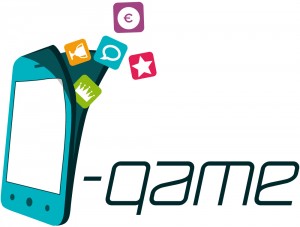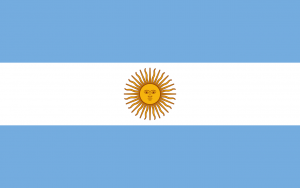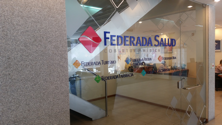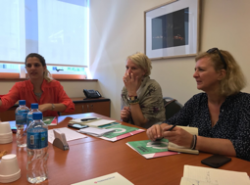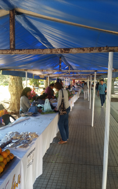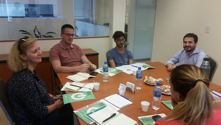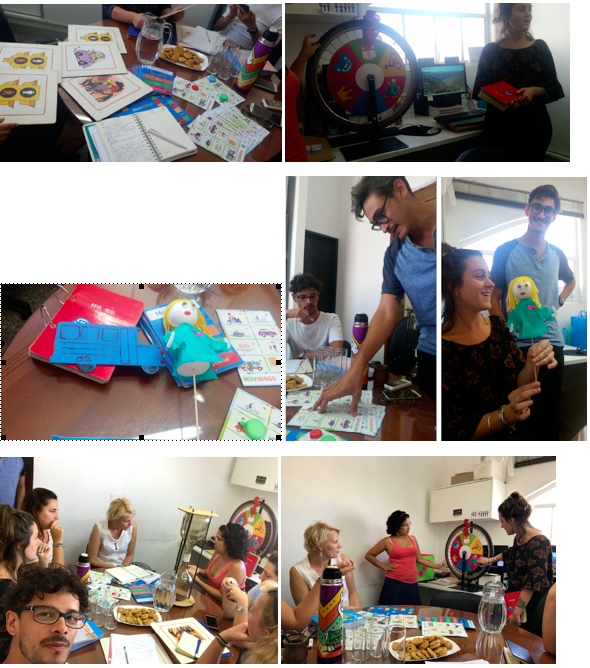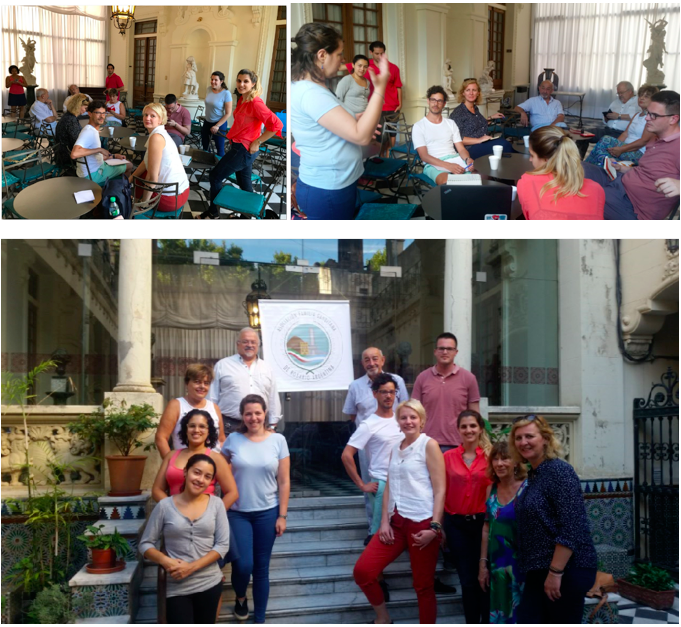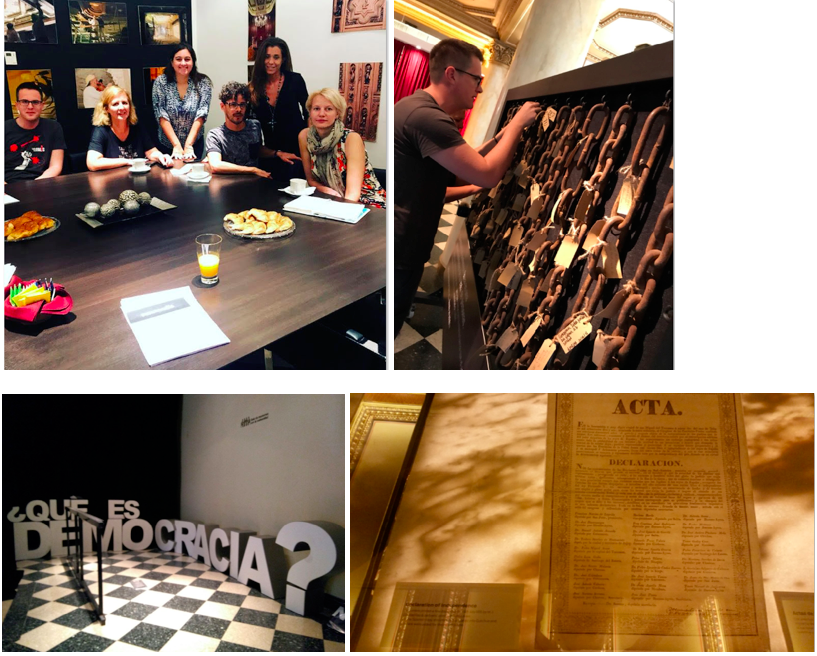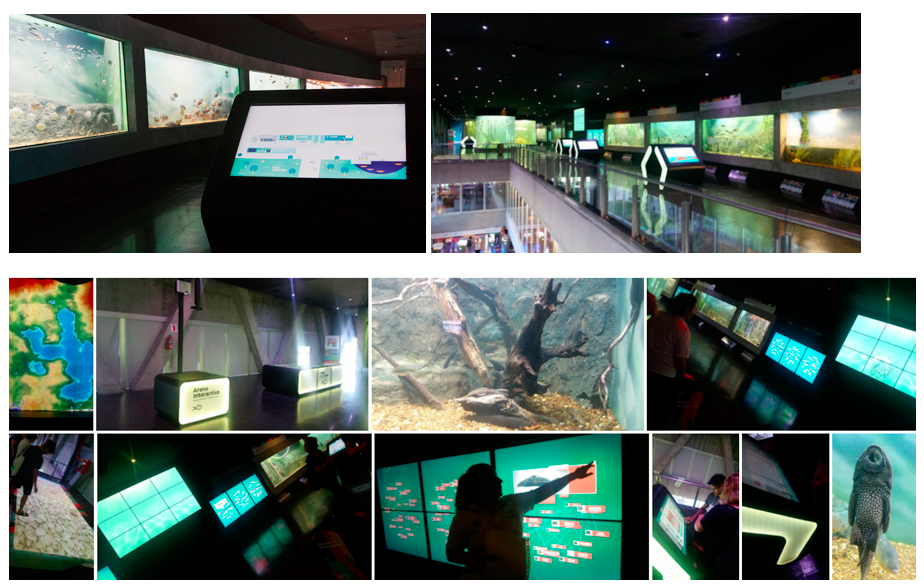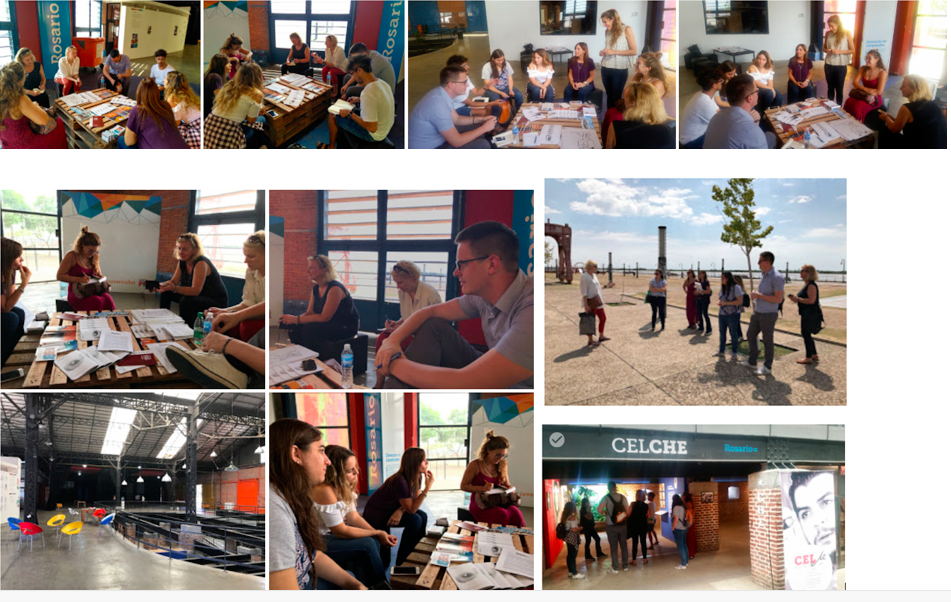„Digital Gamification for youth engagement”
in Argentina
9.-19. March, 2018
|
Description:
Visit is organized
- to gain better understanding of youth NGOs experience in youth involvement in different regions and in different areas, as each region and organization has specific targets, problems and management;
- to indicate where gamification can be used and how it effects target groups and to help recognize gamification as equal method.
Project partners will study the regional, local and organizational experience in each organization and meet proper stakeholders. Youth workers and youth leaders will discuss ways of engaging youth for taking actions for their communities, exchange good practices and discuss possible boundaries of engaging young people in social activities. Results of the visit and discussion will be transformed into the inputs in handbook, curriculum and gamification tool.
Indicators:
- visit organized;
- organizations and relevant stakeholders from region educated of the possibilities of applying gamification in youth work;
- youth workers/trainers from European partner countries shared experience on youth engagement and gamification;
- at least 200 persons in each partner country informed on results via partners’ home pages and social accounts.
Results:
Fundación Federada
http://www.fundacionfederada.org.ar/
Description: interest of the organization is the health care and welfare of people, make contributions in the fields of health, education, research, culture and any other significant field in the pursuit of the common good, as a complement and openness to the community of services that organization offers to its associates. Organization promotes and supports social and solidarity based economy, innovation, development and sustainability in the region. Organization also works with and supports social entrepreneurship by providing microcredits and by helping of organization of voluntary work. Organization implements a program which helps young people to start an internship and employment, provides health insurance, mandatory health checks; trainings in social business, social and solidarity economy.
Obstacles for involvement of youth, to attract; conclusions:
- not always young people see job opportunities after graduation. Internship is the way to help young people to find an exact job, get practice;
- lack of practice;
- communication and attraction of youngsters
- mainly in Facebook
- social media groups
- network od associates
This visit gave the 1st insights into social and ecumenical situation of the Rosario and Argentina in general. Rosario, located 300 km north of Buenos Aires in the province of Santa Fe, is a city of contrasts. Over the course of the country’s economic recovery, following a disastrous collapse at the turn of the century, enormous amounts of money have been injected into the city, particularly thanks to the ‘boom’ in soya exports – around 65% of the countries grain exports depart from ports located in Greater Rosario. While the city centre presents the image of a prosperous and flourishing local economy, for many residents the legacy of economic restructuring of the 1990s, which destroyed the region’s heavy industry (petrochemical, chemical and steel) and with it the major source of employment, has not been overcome. A report by the Permanent Household Survey (first trimester, 2015) indicated that Greater Rosario is the region with the second highest level of unemployment in the country: 8.8% (the national average is 7.1%). According to the report, 72% of the unemployed are aged between 18 and 36 (the national average is 66%). The highest proportion of the city’s unemployed are within the 20-29 age bracket. According to a study by the Universidad Católica Argentina (UCA), and statistics from the provincial government of Santa Fe and municipal government of Rosario, of the 350, 774 young people aged between 0 and 19 in greater Rosario, around 70,000, over 18%, face food insecurity. Some 140,000 (40,2 %) do not have social security and close to 180,000 (55,5%) live in poor environmental conditions. Approximately 105,000 mil (31,4%) live in homes classed as ‘poor’, while close to 25,000 (7,7%) live in ‘indigent households’. In 2012, the government released a report showing that in Rosario more than 150,000 people (30,000 families) were living in ‘informal settlements’.
(Source https://www.swansea.ac.uk/media/Vulnerableyouth.pdf). This illustration gives an idea of the importance of social services and support, especially young people, by entering education and work.
Ente de la Movilidad
Description: the organization plays a role between municipality, transportation system of the city and citizens:
- informs citizens about new transportation projects in the city in the “easy to understand” way, mostly via games;
- educates society on sustainable transport means by and sustainability of the city with formal and informal educational methods;
- organizes cycling classes for citizens and kids;
- stimulates interaction between citizens and municipality, initiates different use of public space;
- work with and in schools, kindergartens, on the street, with patents;
- promote that “The city is a space for cooperation!”;
Obstacles for involvement of youth, to attract; conclusions:
- When visiting schools, the “children-parents” effect is used. To educate children about the city’s environment and opportunities, this information also comes to parents, thus informing the whole community in the city.
- The city’s public space, the public parts of the street are used for artistic activities, thus attractively attracting both children and young people. Children are interested in telling self-taught stories, which are stimulated through various games. Children’s summer schools and workshops are organized.
- #park(ing)day http://rosarionoticias.gob.ar/page/noticias/id/10754/title/Rosario-se-sum%C3%B3-al-evento-mundial-Parking-Day
- Future newspaper
- ICT tools are used for traffic organization, for instance, for parking of the cycles.
- Different board and interactive games are used – games are considered as the most attractive and effective way for everyone (not only kids) to get involved in community life.
–
Asociación Civil Familia Gangitana de Rosario
http://gangitanosderosario.com.ar/
Description: oriented towards civic engagement through cultural and heritage activities and sustainable way of living of youth; civic engagement through culture; environmental campaigns, sustainable use of resources.
–
Fundación para la Democracia Internacional
http://www.fundacionparalademocracia.org/
Obstacles for involvement of youth, to attract; conclusions:
- Young people are overloaded with information and tools, but they don’t have a practical skill.
- “They know everything, but don’t know nothing”.
- Youngsters have to be trained working in team, teamwork, responsibilities; human, personal communication; how to act individually; how to take a decision.
- Lack of motivation
–
Acuario del Río Paraná
http://www.acuariodelrioparana.gob.ar/planea-tu-visita/
Description: The aquarium is designed as an educational institution that simultaneously visually and practically demonstrates the biodiversity of the Parana River. The aquarium has a natural environment for growing fish, as well as a natural riverbank, which gives an insight into the habitats of the river’s life. In the aquarium’s rooms there are laboratories in which fish are grown and cultivated, and visitors can participate in separate laboratory steps. Aquariums show the entire riverbed with its living fish.
Interactive games placed in aquariums, which provide the opportunity to learn more deeply and continuously the river life, inform about ecology and habitats.
The aquarium is a very popular place for visits to both schools and families; it is visited by class, children of different ages.
Obstacles for involvement of youth, to attract; conclusions:
– The interactive environment gives more interest in topics such as ecology, habitats, river inhabitants;
– Digital games located at the aquarium’s premises are very popular not only among children but also among adults, they allow not only to learn, but also to test their knowledge.
–
Centro de la Juventud
https://www.rosario.gov.ar/web/ciudad/jovenes/talleres/talleres-en-el-galpon-de-las-juventudes
Description: Youth Center of Rosario is a very important place for local young people. The center works with youngsters from 13 years old, and work with different project. In the activities center involves all divers young people, for instance, young parents. The activities let them – youngsters be more involved in the city life, let them express their voice. A lot of youngsters in the Rosario (remember basic information gathered about realities in Rosario during the first visit) have problems with access to education and work, so the center gives more chances to them. The center is the central place, but in the city in each district they have specific place where young people can gather together and spend meaningful time. Center in cooperation with municipality have implemented a project “Digital spots” in scopes of which the places where an internet access is provided. The aim of the project is to lower the digital gap between generation. “Puntos digitales” includes also workshops for development of digital skills.
Obstacles for involvement of youth, to attract; conclusions:
- The involvement of young people in different activities is directly related with the accessibility – as closer the activities take place to their living place, as more involved youngsters are.
- The role also is playing the quality of the place – it should offer qualitative activities, which afe interesting for participants, attractive, educational.
- A lot of young people are unstable – they often start activities, but then interest disappears. They need to be learned of perseverance, to continue and to finalize what has been started.
- Workshops have a special importance for young people in the center – they getting to know each other, they have a possibility to meet, learn divers attitudes. In the center there is no difference whether you come for rich or poor environment, you have an education or not, and environment in the center is build that everyone can feel comfortable, because young people are tended not to accept each other. Workshops are mainly the chance to meet.
- Center is a platform of games and activities to help young people to recognize themselves, express feelings and emotions.
- To attraction of more youngsters, center use celebrities and attractive persons to empower youngsters.
–
PUERTA 18
Description: Youth NGO, started 10 years ago, working with kids and teenagers. Despite the fact that everybody has access to the Internet and Facebook, the organization is working to help young people use technologies meaningful, for example for self-development and education. They teach kids programming and coding. The programs and tasks are divided for several age groups. 13-18 years old are learning to use technologies through games and tools for education, 18-24 – go deeper in technologies and the program is accredited as vocational education program. Besides technologies, organization also hold a workshops for development of soft skills (creativity, body language, communication). Main objectives of the organization are: contribute to the discovery of vocations and promote their development, strengthen the educational journey, reduce the digital divide, acquire tools to improve future employability, encourage community participation. Puerta 18 is a part of The Clubhouse Network, an international community of 100 Clubhouses located in 18 countries, providing youth with life-changing opportunities for 25 years.
Obstacles for involvement of youth, to attract; conclusions:
- Reaching youth is not about creation of more spaces, but about networking and spreading ideas.
- It is not about makes places with computers, it is about content you can reach there, people you can meat and realize your ideas.
- The organization is different because they are not an IT organization, but youth organization, working with IT tools.
- The main challenges:
- To reach the youngsters with the most needs, have to work with NGO’s, shelters;
- Social media are very important tool to reach out youngsters, but it has to be used smartly;
- Information flow “mouth – to – mouth” is very important. Young people need a confirmation from their pears that something they do is good;
- Every day challenge is to provide activities for youth to come to the center;
- Community is very important;
- Selection of staff – persons who love to work with kids, not only specialists of the field;
- It is important to ensure the save place, where diversities can meet.
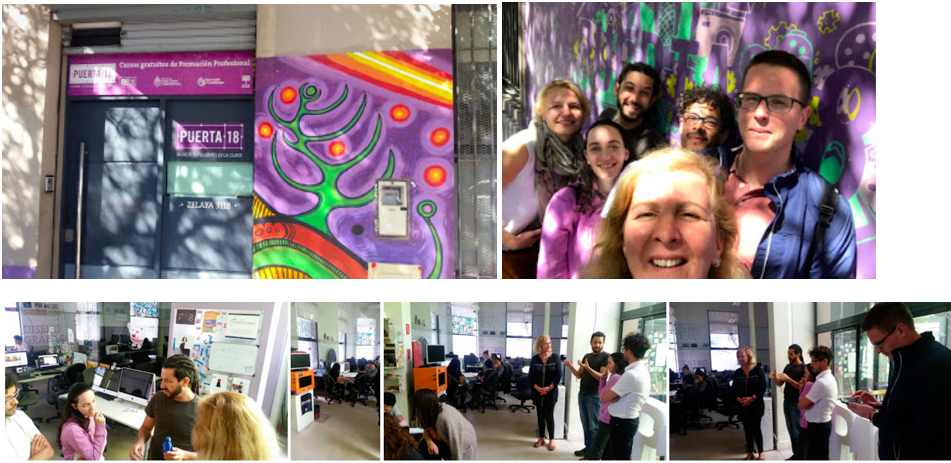
—
National Ministry of Social Development
http://ghdx.healthdata.org/organizations/ministry-social-development-argentina
Description: Former secretariat of Youth, works with ministry and associations, compliment youth organizations work with new tools, equipment, skills-trainings, give young people to try things to see own opportunities.
Obstacles for involvement of youth, to attract; conclusions:
- Because of diversity of society (whish the team has an opportunity to observe and which was highlighted during several visits), the youth need to have a safe space, a space of comfort and communication, and only then you can provide the workshops, give the practical skills.
- Youth need not only skills, but also cultural activities, especially for social inclusion.
- Mix of traditional and digital workshops;
- Community building, mentorship in local areas.
- Jobs and skills training fairs.
- Microcredits, seed capitals.
- Give a chance to speak with specialists, experts, via digital tools, chats, digital communication.
- As usually the challenges are the budget – money for organization of qualitative workshops and spaces.
–
Life Argentina
Description: A nonprofit, civil society organization that works with youth living in socially marginalized and extremely impoverished areas of Argentina. Carry out a number of programs and activities with the goal of providing for the healthy development, happiness, and a hopeful future for the children work closely with. work collaboratively with community centers and soup kitchens in the city of Buenos Aires and its suburbs.
The official statistics are that 60 percent of the children in Argentina live under the poverty line. We work regularly with youth living in poverty providing recreational, educational and social activities as well as food, clothing and supplies.
Obstacles for involvement of youth, to attract; conclusions:
- The organization is working with kids and families in total marginalized areas, where are families with HIV-infected parents, children have different fathers, in the area of 9 square-kilometers live around 30000 persons. In this situation the impact can be made in the very primitive level. For example, to get kids to participate in workshops, you have to provide some food, some things they need and what they can’t have.
- Families often don’t want to let their kids to access this support, because this will interrupt and brake the “circle”, they don’t want a better situation for their kids.
- To attract volunteers to work in this area is also hard. Since the area has own rules, not everyone is accepted there, even if you want to help. The main tasks of volunteers are to provide and help with a school support, English classes, recreation, sports, birthday parties, cooking classes, sexual education, etc.
Final conclusions:
Despite the fact that each organization has its own specifics in its activities, the leading element – need for places where young people and kids can spend meaningful and qualitative time, in safe environment where diversities can meet.
Gamification is evaluated as tool for:
- Meeting with the peers
- Self-development
- Identification of further personal development needs
- Soft skills training
- Practical life skills training
- Identification with society
Angel Casal, project manager
“INVOLVED ngo”
Tallinn, 20/04/2018
